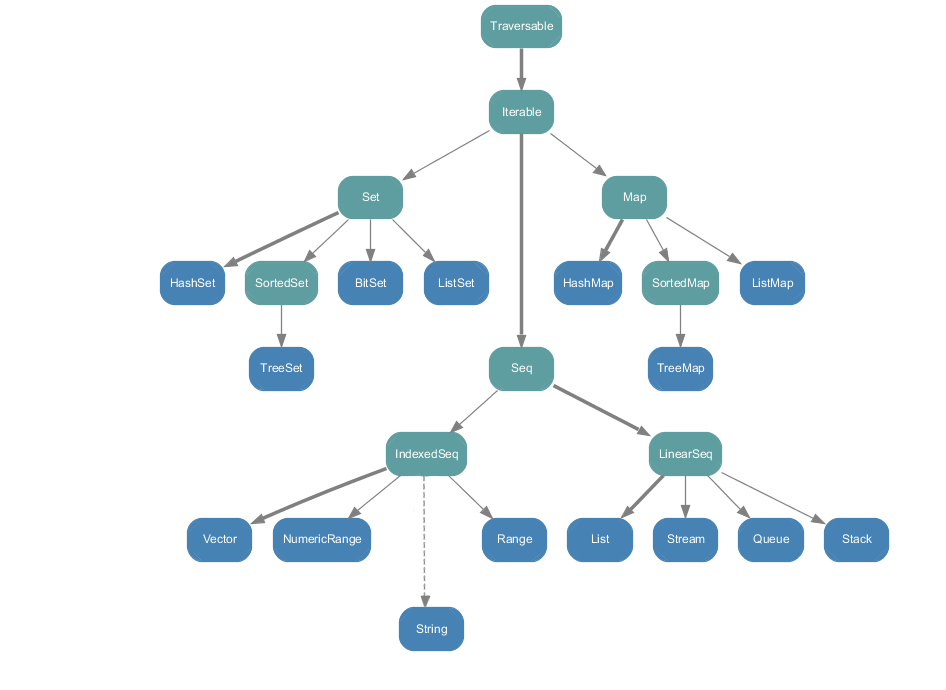So far we have seen List as the main example of collections. However, just as there are many implementations
for collections in Java, there as also many variants of them in Scala. This section will cover conversions
between Java's and Scala's collections and list a number of useful operators that are commonly used in collections.
While using Scala, you are quick to discover that some external libraries you use are written in Java and
therefore can return Java collections (hereafter called 'jCollection'). However, you instead want to use
Scala collections (hereafter called 'sCollection') as these define more operators to work with in a functional
way. On the other hand, some Java based libraries explicitly ask for a jCollection as their input, while you
have a sCollection at hand. Scala provides special operators that do these conversions for you. First make
sure you import scala.collection.JavaConverters._. This adds extra methods to your collections to transform
one into the other.
import scala.collection.JavaConverters._
val jList = List(1, 2, 3, 4).asJava
val sList = java.util.Arrays.asList(1, 2, 3, 4).asScalaNote: Besides scala.collection.JavaConverters there is a scala.collection.JavaConversions. This does
the transformation for you without explicitly typing asJava or asScala. However, in some cases this may
lead to unexpected behavior. Therefore always use the JavaConverters method of conversion! For an example,
see this explaination
on the easy-bag-store project.
A common misconception between Java and Scala is the naming of collections. Java defines an Iterable with
subtype Collection, which itself is the supertype of the List, Set and Queue interfaces (as well as some
other classes). The List interface then goes on to be the supertype of many implementations, such as ArrayList,
LinkedList and Vector. Note that these implementations are all (as of Java 8) mutable collections!
Scala has a much more complicated structure in its collections API (we don't recommend studying this too much if
you don't need to!), but the gist is that it defines an Iterable similar to the one in Java. This trait has a
number of subtypes, among which are Seq, Map and Set (note that Scala skips Java's Collection step and
considers a Map to be a collection as well). The Seq trait in Scala is comparable to Java's List interface.
This trait is the supertype of (amongst others) the List class, which is equivalent to Java's LinkedList!
| Java | Scala | |
|---|---|---|
| Interface | List |
Seq |
| Implementation | LinkedList |
List |
Notice in this image that also Scala's String class is in a sense part of the collections API. This makes
sense, as a String is actually just a sequence of Chars. The main purpose of this is to be able to have
the operators that are defined on collections as well on a String.
In this same way we can view the Option as a collection as well. The None case corresponds to an empty collection,
whereas Some(a) corresponds to a collection with one element a in it. In fact, Scala does define the Option
as a collection, so you can view it as such and mix it in in case you need to!
Finally, a Map is viewed as collection of key-value-tuples. Therefore operators like map, filter, flatMap
(and many more) have a function-argument like (K, V) => A, meaning that their input consists of both the key and
the value.
In the previous sections we have discussed various operators on List, mainly map, filter and flatMap, which are required for doing for-comprehensions. However, there are many more operators on collections. We encourage you to have a look in the corresponding ScalaDocs of Seq, Map, List, etc. In this section we will highlight a couple of the most commonly used operators. We encourage you to experiment a bit with these operators, such that you have a good understanding of their behavior.
drop(n: Int)discards the firstnelements from the collection and only processes the remaining elementsdropWhile(p: A => Boolean)discards all elements as long as they satisfy the predicatep. Once the predicate is satisfied, all remaining elements will be used in (optional) further processingexists(p: A => Boolean)tests whether at least one element in the collection satisfies the predicatepforall(p: A => Boolean)tests whether all elements in the collection satisfy the predicatepgroupBy[K](f: A => K)collects all elements of the collection into various groups, based on a common key of typeK. The results are collected in aMap[K, List[A]]partition(p: A => Boolean)separates the elements that satisfy the predicatepfrom the ones that don't and collects the results in two lists that are returned as a tuplescanLeft/scanRightdoes the same asfoldLeft/foldRightbut keeps all intermediate results. This is useful to maintain some state throughout the sequence of operators.span(p: A => Boolean)splits a list into a prefix and suffix according to the predicateptake(n: Int)keeps the firstnelements and discards the rest of the collectiontakeWhile(p: A => Boolean)keeps all elements as long as they satisfy the predicatepzip(that: Iterable[B])merges the collection pairwise with another collectionthatinto a collections of tuples(A, B)zipWithIndexcombines the elements of the collection with their index, starting at 0
Finally we refer to this blog post for tips & tricks and some best practices regarding the use of the operators defined on collections, Option and Try.

